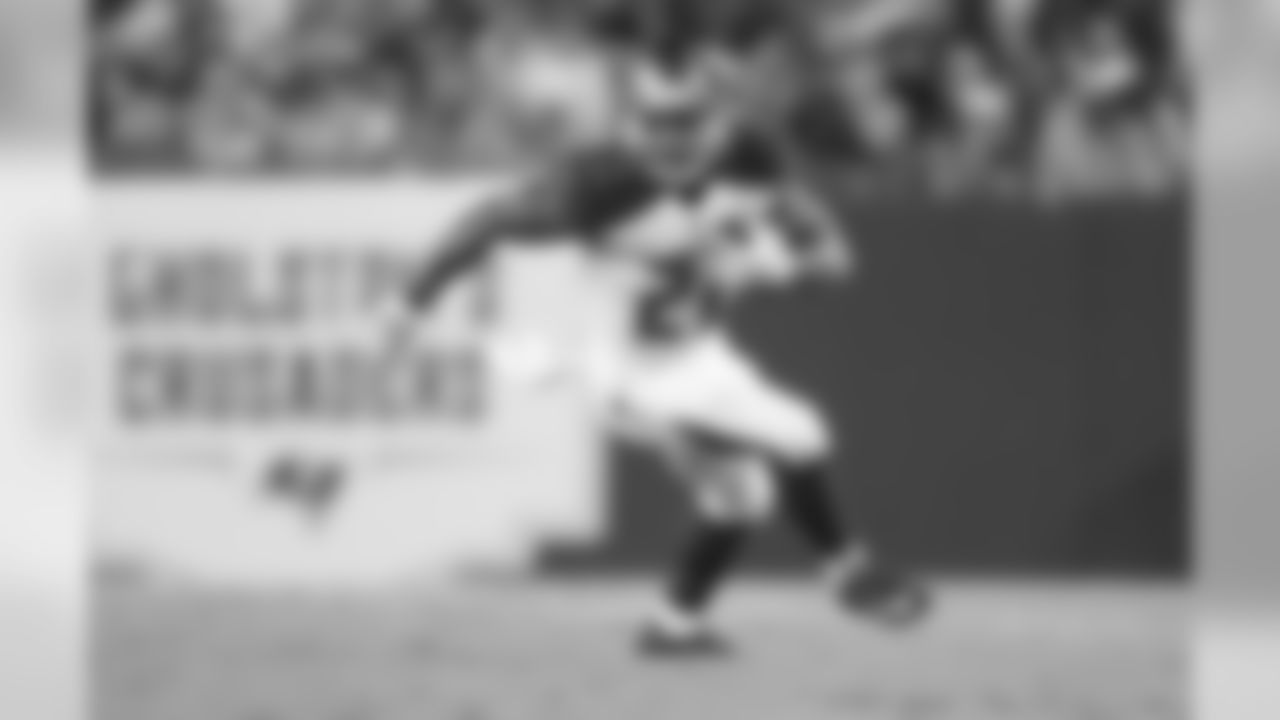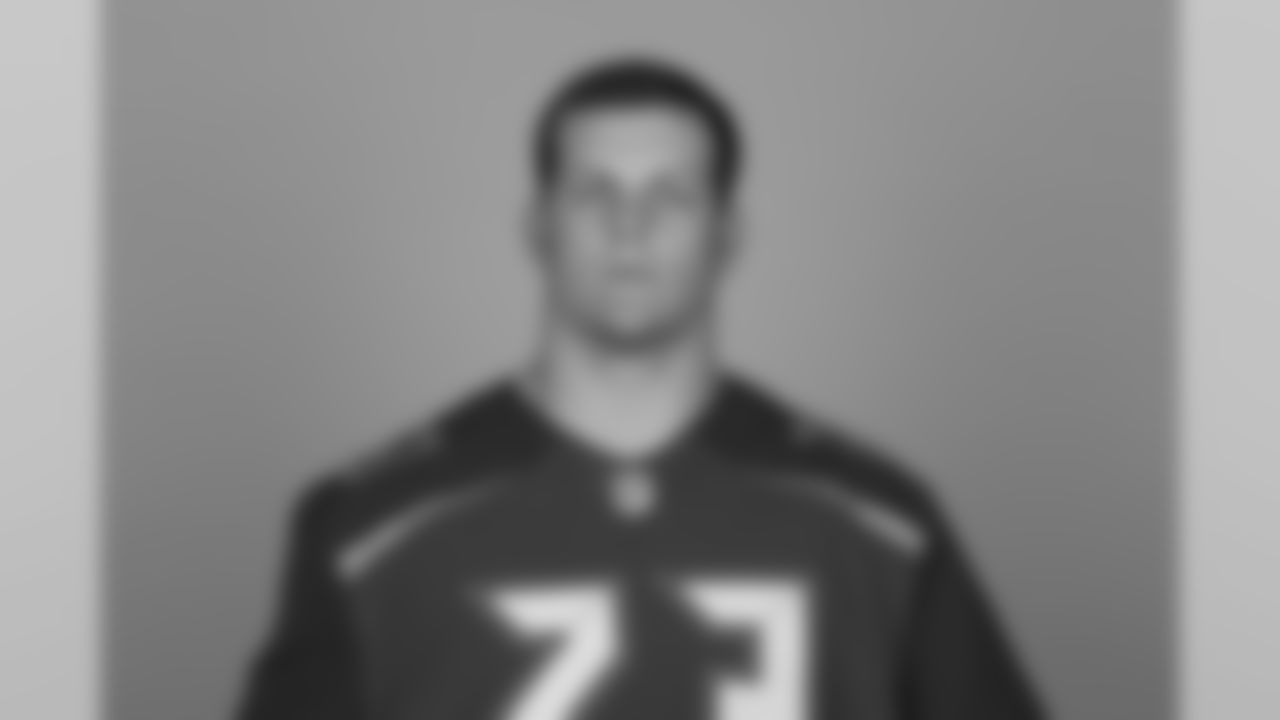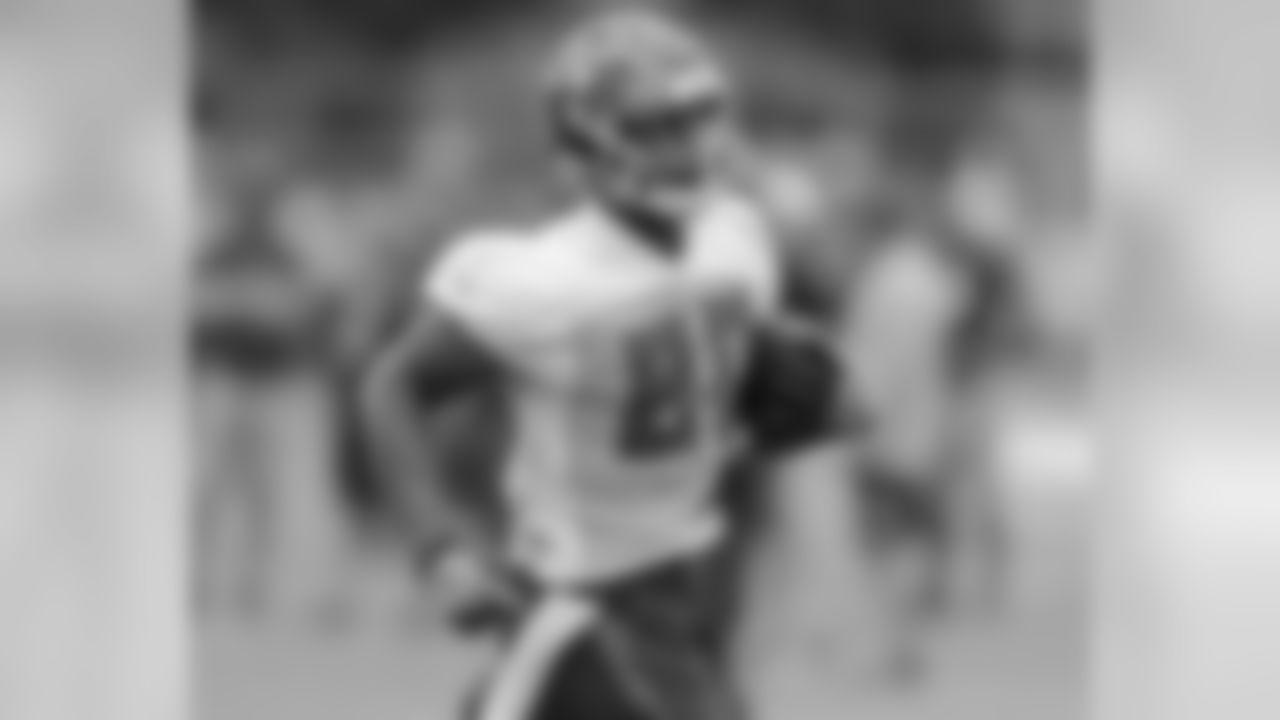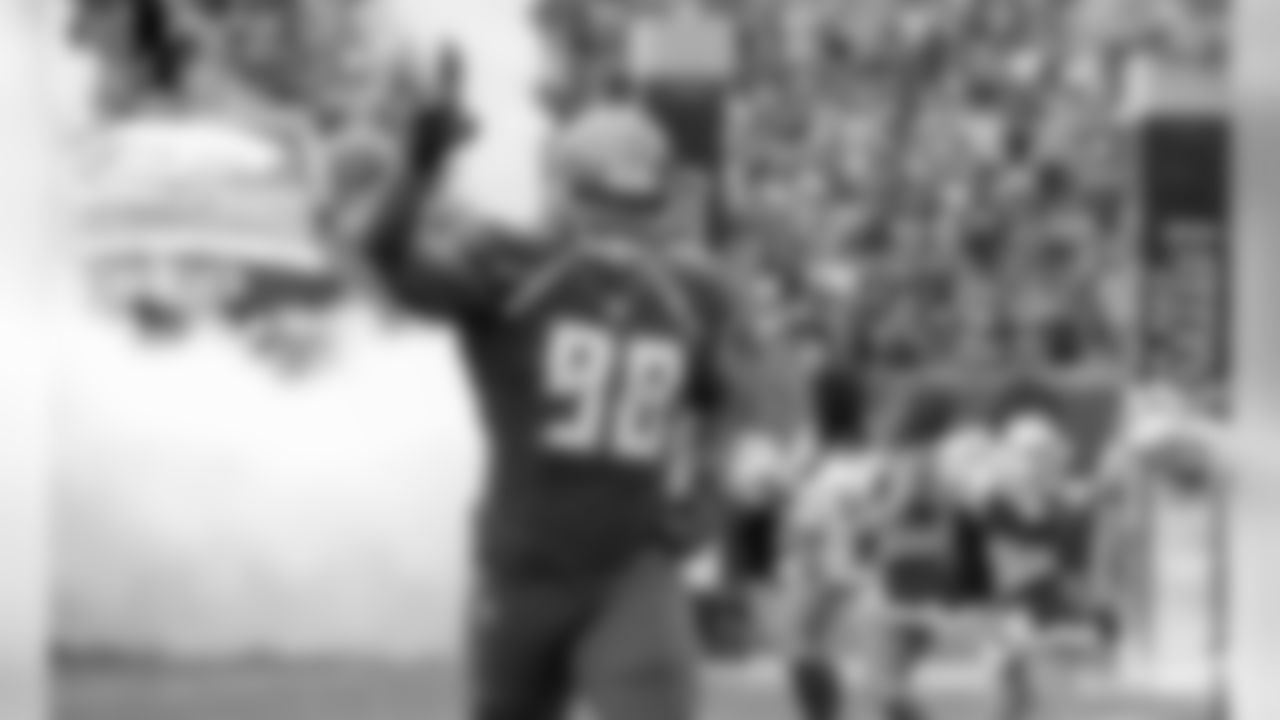*
Photos of the Buccaneers' complete roster.


2 K Nick Folk

3 QB Jameis Winston

9 P Bryan Anger

10 WR Adam Humphries

11 WR DeSean Jackson

12 WR Chris Godwin

13 WR Mike Evans

14 QB Ryan Fitzpatrick

18 WR Bernard Reedy

21 S Justin Evans

22 RB Doug Martin

23 S Chris Conte

24 CB Brent Grimes

25 RB Peyton Barber

26 CB Josh Robinson

28 CB Vernon Hargreaves

29 DB Ryan Smith

32 RB Jacquizz Rodgers

34 RB Charles Sims

35 CB Javien Elliott

36 CB Robert McClain

37 S Keith Tandy

43 S T.J. Ward

51 LB Kendell Beckwith

52 LB Cameron Lynch

53 LB Adarius Glanton

54 LB Lavonte David

56 DE Jacquies Smith

57 DE Noah Spence

58 LB Kwon Alexander

59 LB Devante Bond

61 OT Justin Murray

62 C Evan Smith

64 OT Kevin Pamphile

65 LS Garrison Sanborn

66 OT Leonard Wester

68 C Joe Hawley

69 OT Demar Dotson

73 G J.R. Sweezy

74 G Ali Marpet

76 OT Donovan Smith

77 OL Caleb Benenoch

80 TE O.J. Howard

82 TE Antony Auclair

84 TE Cameron Brate

88 TE Luke Stocker

90 DE Chris Baker

91 DE Robert Ayers

92 DE William Gholston

93 DT Gerald McCoy

95 DE Ryan Russell

96 DE Sealver Siliga

98 DT Clinton McDonald

DE Will Clarke
Each week during the offseason, Senior Writer/Editor Scott Smith will dip into the inbox to answer questions from Buccaneer fans. This week we start with a discussion on wide receiver DeSean Jackson and what his addition to the offense has meant to the Bucs' playbook. We also allay one fan's worries about O.J. Howard's vertical leap at the Combine and debate the value of trading up during the draft.*
Fans can submit questions for upcoming mailbags via Twitter to @ScottSBucs (#BucsMailbag), through a message on the Buccaneers Official Facebook Page or via email at **tbbsocial@buccaneers.nfl.com*. The One Buc Mailbag runs every Thursday and is not necessarily meant to reflect the opinions of the team's management or coaching staff.
*1. Editing the Playbook? Scott, When teams like the BUCS pick up top tier Free Agents like DeSean Jackson or new players through the draft like Jameis Winston, how much work goes into changing the play book? I would imagine the play callers "create" new plays to fit the skill set of the players which could be a lot of work for the OC, and DC which in return affects the entire team in learning the plays. Just wondering Thanks, Rodney Smith (via email to tbbsocial@buccaneers.nfl.com)
Thanks for the question, Rodney, and thanks for being patient! (I had promised Mr. Smith I would answer his question last week, then plum forgot. Better late than never, I guess.)
This isn't really as much of an issue as you might think, Rodney. In general, there aren't a lot of unique concepts in any offensive playbook around the league. You've heard about the NFL being a copycat league, right? I'd imagine you've heard that about a billion times; I know I have. If something works, everybody is going to try it out. Plus, there is so much overlap between coaches' careers around the NFL that concepts get passed around and playbooks take shape from many different influences.
WATCH: THURSDAY'S PRESS CONFERENCES
What I'm saying is that the addition of a player like DeSean Jackson, who in this case gives a team a big dose of the speed and explosiveness it was missing, doesn't really lead to a marathon chalkboard session among the coaches. What it does, to put it more precisely, is allow you to unlock some areas of your playbook that you weren't able to take advantage of before.
DeSean Jackson in a sense replaces Vincent Jackson, even though Vincent didn't play a whole lot last year due to injuries. But Vincent Jackson was a very productive starter for the offense for years, and that's what the Bucs hope DeSean Jackson will be in his vacated place. They won't be the same type of player, as you obviously know, but that just means different play-calls or different substitution patterns, not a whole new array of plays.
"I don't know if you add plays to the playbook," said Offensive Coordinator Todd Monken in response to Rodney's question. "I just think there are certain things that, one, you might not have to sub in order to get to. For instance, let's say you're trying to throw the ball over the top. Maybe Vince wasn't the same type of player as DeSean in terms of getting there. From a blocking standpoint, it's the reverse of that. So you have a different skill set that you have to mix and match. You can maybe take more shots down the field. You can utilize his run-and-catch maybe a little bit more.
"Vince brought a lot to the table in terms of size, ball skills, maturity, he was a really good route-runner, and he had good speed. But obviously you add somebody of this element [in DeSean Jackson]…you're not going to really change anything, but you may do a few more things with him trying to get him the ball."
As for the effects all of this might have on the defensive coordinator and his players, well, my first thought would be, "Too bad." I mean, don't we WANT our offense to be extremely difficult to defend, and to figure out. Hopefully, Tampa Bay's defense is very much stressed by what happens on offense in training camp. And, hopefully that just serves to make the defense better in the long run.
2. Howard's Range?
Hello Mr. Smith,
The first thing i want to say before i phrase my Question is that i absolutely loved the O.J Howard pick (maybe thats becouse im from germany and i just couldint care less about Florida State) but there is this one thing about him that concerns me only that one and thats his jumping ablility. His vertical of 30 isint good it really isint ! Njoku for example jumpt 7 inches higher and that gives him a bigger range although he is 2 inches smaller ( size + vertical + arm is 144 to 136 inches) witch can be big in de redzone. i did read somewhere ( cant rememberer where sorry ) thet every Probowl TE in the las Decade or so jumpt higer than that EVERY. Maybe im paranoid but i thing that could be an issue!? What do you think ?
Daniel Müller (via email to tbbsocial@buccaneers.nfl.com)
PS: sorry for my bad English
First, Daniel, please don't apologize for the level of your mastery of the English language. I can guarantee you I couldn't come close to matching that effort in German, particularly in writing. So I have no problem understanding what you have written; I do have a bit of a problem understanding the depth of your concern on this issue. You sound like you're looking for reassurance that O.J. Howard's vertical leap result at the Combine isn't an indication of something like in his game. Well, allow me to provide that.
Let's look at the numbers first. You are correct that Howard's vertical leap score at the Combine was 30 inches, and also that his score was not among the best put up by this year's tight ends. David Njoku, who went 11 picks after Howard, scored a 37.5" The best mark was 39" by Virginia Tech's Bucky Hodges. So, from a relative standpoint in terms of this group of tight ends, 30" isn't "good." It's also not any sort of red flag. Before 2017, the last tight end drafted in the first round was Eric Ebron, the 10th overall pick in 2014. His vertical leap was 32". And, I'm sorry, but your contention about all previous Pro Bowl tight ends is too vague and unsupported for me to take the time to prove and disprove it.
Besides, it wouldn't matter. What you need to keep in mind about the NFL Scouting Combine is that it is just one tool in a very long scouting process. It is a piece to the puzzle, but there is so much more that goes into evaluating a player. The Combine is definitely important, don't get me wrong, but not every number that comes out of it is crucial. Don't take my word for it; read instead what Buccaneers Tight End Coach Ben Steele has to say on the matter.
"I think you look at all the different drills that they do at the Combine, the tests that they do, and you kind of take them all in stride," said Steele. "Then you see how those transition onto the field. In my opinion, that is not a huge concern at any position, to see how a vertical jump transitions to a guy making plays. It's obviously a test for a reason, to see a guy's explosiveness, but you see O.J.'s explosiveness on the field."
NFL scouts and coaches pay very close attention to what happens at the Combine, but the most important thing they watch is game tape. It's not that vertical leap that tells the Bucs what Howard can do; it's what they see him actually doing in games, which is frequently special. To be specific, the Buccaneers are not at all worried about Howard being able to win jump balls.
"No, that's not an issue," said Steele. "The tape proves it. He obviously can go up and make the high-ball catch."
Keep in mind that when you fret about Howard's vertical being less than some of the other tight ends that he's not going to be fighting for high passes with other tight ends. A 6-6, 251-pound tight end with 4.5 speed, an 80 5/8" wing span, 10" inch hands and a 30" vertical leap? That's a nightmare matchup for many, many defensive backs and linebackers. And if a jump ball becomes a matter of strength, Howard's 22 reps on the bench press were better than every tight end except Ashland's Adam Shaheen, who did 24.
Remember Bucky Hodges, who blew away the Combine field in the vertical leap? He went in the sixth round, 183 picks after Howard. There's a lot more to dominating at the tight end position than jumping three feet in the air.
So don't worry, Daniel. And thanks for rooting for the Bucs from so far away!
3. To Trade or Not to Trade?
Scott-
I think the Bucs last three or four drafts have been pretty good overall, I really do. Seems like a good number of the picks have worked out (especially Winston and Evans and Kwon Alexander) and I'm hoping that will be true of OJ Howard and Godwin this year too. The one thing I don't really like about Jason Light's drafts though is that I think he trades too many picks away. It seems like we don't make a lot of picks on the last day of the draft, and we could probably use a few more guys, at least for competition. Don't teams think that it's best to load up on as many picks as possible now a days? Like, Cleveland and New England purposely do that so they have a better chance on hitting on some picks if they have more of them. Anyway, what do you think about that? Should we trade less often during the draft? Thanks for your time. – Kelly S. (via email totbbsocial@buccaneers.nfl.com)
Yes, Kelly, I believe there is a growing league-wide acceptance that hitting on a draft pick – at any spot in the seven rounds – is less of a sure thing than anyone would like. If you believe that, even while being confident in the scouting abilities of your own crew, then it makes sense to try to get as many picks as you can in order to up your odds of coming away with useful players. However, I think most teams are interested in stockpiling picks in the first three or four rounds. That's the key.
While we know that a first-round pick can bust, and that it happens every year, you still have a much better chance of finding an impact player in the first or second round than in the sixth or seventh. Theoretically, a team might be able to amass enough seventh-round picks to give them the same chance of landing several impact players as they would get in the first few rounds, but that would be practically impossible. Also, I'm not sure that NFL execs really believe that. Many teams still reportedly refer to the "Draft Trade Value Chart" that the Cowboys first developed, and there's a stark difference in the perceived value of later-round picks as compared to first and second-round slots.
In fact, if you use that chart and add up the value of all 32 seventh-round picks, you get 256.3 points. The last pick of the first round is valued at 590 points. Those 256 points are equivalent to the first pick of the third round.
I say this because I would argue that over the last four years Jason Licht's Buccaneers have not traded away their early picks. About a month before this year's draft I posted a story detailing every trade Licht had made involving draft picks since arriving in 2014. The Buccaneers were somewhat more active in these types of deals than most than the average team in that span, though certainly not outrageously so.
There were 12 trades covered in that story, and Licht swung two more during the 2017 draft, so we have a total of 14. Two of those were deals made at different times of the year in order to acquire guard Logan Mankins and defensive end George Johnson. In five of them, the trade involved a net loss of total picks for the Buccaneers so they could move up in the draft. One other involved an equal number of picks on both sides, with the Bucs making a small move up (to get Ali Marpet) and making a larger move down a few rounds later.
So that's six deals that would loosely fall into the type you describe, Kelly. Here's what each deal cost the Bucs:
- A 2015 5th-round pick to move up from the 7th to the 5th round in 2014 (drafted Kevin Pamphile)
- A move down of 19 spots in the 4th round in 2015 to move up from the top of the 3rd to the bottom of the second round in 2015 (drafted Ali Marpet)
- A 2015 7th-round pick to move up four spots in the 4th round in 2015 (drafted Kwon Alexander)
- A 2016 4th-round pick to move up from the 3rd to the 2nd round in 2016 (drafted Roberto Aguayo)
- A 2017 6th-round pick to move up from the 4th to the 3rd round in 2017 (drafted Kendell Beckwith)
- A 2018 7th-round pick to move up 14 spots in the 7th round in 2017 (drafted Stevie Tu'ikolovatu)
Add it all up and the Buccaneers' trade-ups in the 2014-17 drafts have cost them one fourth, one fifth, one sixth, two sevenths and an additional move down of 19 spots in the fourth round. That last bit there, the move from #109 to #128 in order to go up four spots and get Marpet, works out to 32 points on the trade value chart, which is the equivalent of a late fifth-round pick. So you can call it one fourth, two fifths, one sixth and two sevenths if you want.
Only one of those picks was in the first four rounds, and that one, used in the move up for Aguayo, had been acquired earlier in the draft for a small trade down in the first round. I would argue that Licht has spent a relatively painless handful of late-round picks to make sure he got Pamphile, Marpet, Alexander, Aguayo, Beckwith and Tu'ikolovatu. I would also argue that Pamphile, Marpet and Alexander have already proved to be good investments. The jury remains out on Aguayo and we obviously can't know yet how Beckwith and Tu'ikolovatu will pan out.
The thing about trading up to secure a coveted player is that you can never be completely sure if it was necessary. Would have still landed the same player if you had stayed put? That said, Licht's crew puts a lot of effort into the scouting of the other 31 teams in the league in order to be able to make educated guesses about what they might do. Usually, a small trade up, like the one of four spots the team made before taking Alexander, is executed because you believe one of the specific teams in front of you has their eye on the same player. A larger leap, say 10 or 15 spots, may simply be a reaction to growing disbelief that a player ranked highly on your draft board is still available. Either way, those trades are made because the team feels it's just too risky to stay put and hope the player falls.
I don't know about you, but I'm on board with that risk. Sure, it would be nice if the Bucs held on to every sixth and seventh-round pick. You never know where you're going to hit. But if it costs one of those relatively low-impact selections (on average) to make sure you get a player who can make a difference, I think it's worth it. Heck, I think the Buccaneers have generally found more players that stuck among the undrafted rookies than their seventh-round selections.
































